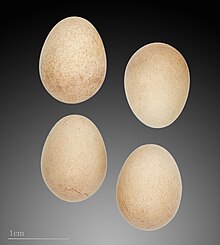Summer golden chicken
| Summer golden chicken | ||||||||||||
|---|---|---|---|---|---|---|---|---|---|---|---|---|
|
Golden Grouse ( Regulus ignicapilla ) |
||||||||||||
| Systematics | ||||||||||||
|
||||||||||||
| Scientific name | ||||||||||||
| Regulus ignicapilla | ||||||||||||
| ( Temminck , 1820) |
The firecrest ( Regulus ignicapilla , Syn. : Regulus ignicapillus ) is a bird art of the genus of Goldhähnchen ( Regulus ) from the family Regulidae. Situated on the island of Madeira occurring firecrest (Regulus madeirensis) was now recognized as a separate species.
description
Like the winter golden cockerel , the summer golden cockerel is one of the smallest birds in Europe . It's about nine inches long and only weighs between four and six and a half grams. It has a wingspan of 13 to 16 centimeters.
The summer golden cockerel also resembles the winter golden cockerel in appearance: it has a yellow-green back, the belly is whitish gray, the wings are darker and have two white wing bands. The best distinguishing features to the winter golden cockerel are the white over-eye stripe and the very noticeable, bright yellow-green sides of the neck (often the best visible feature in the field), which make the species appear a little more colorful than the winter golden cockerel. The black stripe above the eye stripe is also a little more pronounced. The sexes look almost the same, only the parting of the male is more orange, while that of the female is more yellow.
The voice is tit-like, a faint sisisisi on one level. The singing consists of a slightly ascending sequence of these notes with a short trill at the end.
distribution and habitat
Goldfinches live in coniferous and mixed forests, as well as in parks. They are not as much tied to coniferous forests as the winter golden chickens, but they also like to be in the treetops. Their distribution area includes southwest and central Europe as well as the mountains of North Africa and Asia Minor. From large parts of Germany and Poland, the breeding birds migrate to southern France, Spain or North Africa in October and return to their breeding areas in April.
food
Goldfinches eat insects and insect larvae, as well as spiders.
Reproduction
The breeding season lasts from mid-April to late July. The nests are deep and thickly padded with moss. They are mostly attached to the underside of a branch. The clutch consists of seven to eleven eggs. They are incubated for 14-17 days. The young leave the nest about three weeks after hatching.
literature
- Lars Svensson , Peter J. Grant, Killian Mullarney, Dan Zetterström: The new cosmos bird guide . Kosmos, Stuttgart 1999, ISBN 3-440-07720-9 .
Web links
- Videos, photos and sound recordings of Regulus ignicapilla in the Internet Bird Collection
- Regulus ignicapilla inthe IUCN Red List of Threatened Species 2011.2. Listed by: BirdLife International, 2009. Retrieved November 16, 2011.
- Age and gender determination (PDF; 2.7 MB) by Javier Blasco-Zumeta and Gerd-Michael Heinze (English)
- Golden cockerel feathers


